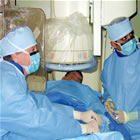| << To Blog Home >> | |
|
|
April 8, 2011 -- 6:50pm EDT Transradial Wrist Angioplasty RIVALs Femoral
That may be changing as a result of an important study presented this week at the American College of Cardiology Annual Scientific Session (the 60th! -- Happy Birthday ACC -- in 5 years you can qualify for Medicare, assuming it still exists!) For a comprehensive review of the study, dubbed RIVAL (RadIal Vs. FemorAL Access for Coronary Intervention Study), read my article on Angioplasty.Org, "Angioplasty and Stenting from the Wrist Safe and Effective: The RIVAL Trial". There was some disappointment when the RIVAL results showed that one method was not superior to the other. You see, "radialists", as they call themselves, are very evangelical about the advantages of the wrist as the access site for diagnostic and interventional procedures. (They call those doctors who dismiss the wrist and are "addicted" to the leg, "femoral-holics".) So the title of this new study, RIVAL, is apt. The radial technique was first described in 1989 by Montreal cardiologist Dr. Lucien Campeau, but it's not been taught in medical schools or most fellowships in the U.S. so, while virtually all interventional cardiologists have been trained in the femoral approach (using the femoral artery in the upper leg/groin area) which has been around since it was perfected by Dr. Melvin Judkins in the 60's, hardly any knew how to utilize the wrist. Except a few pioneering cardiologists, like Dr. Tift Mann, or Dr. John Coppola who, after having a patient die from access-site bleeding complications after a successful angioplasty, decided to go to India and learn this technique from Dr. Tejas Patel. Dr. Coppola describes this journey in his exclusive interview in Angioplasty.Org's Transradial Access Center. That was less than a decade ago. Today things are different. Equipment is smaller, catheters are thinner and can go through smaller arteries, even a new stent (investigational in the U.S.) is called "a stent-on-a-wire", made by Svelte Medical. Imaging manufacturers are also getting into the act. Toshiba Medical just announced a new cath lab installation "optimized for the transradial approach". However, with new and very potent antithrombotic drugs that can help prevent clotting during interventional procedures, especially in STEMI, excess bleeding, especially at the catheter access site, has become a concern. Enter transradial: lower (or no) bleeding complications, increased patient comfort, because there is no need to lie still for hours, with heavy pressure on the femoral artery, or even need for a vascular closure device. And with smaller, thinner equipment, almost any complex procedure can be performed from the wrist. The only problem is very very few cardiologists can do a radial procedure. That too is changing, and I talk about that in my article too. So very soon, the joke Robin Williams tells about his heart procedure ("Who knew that the way to a man's heart was through his groin?") may be...well, he'll just have to work the wrist into it somehow.... ;-) |
|


 The
European cardiologists don't understand all the fuss in the U.S.
about wrist vs. groin, radial vs. femoral. They use
the wrist artery for angioplasty, stents and catheter access at
least half the time (many 80-90% of the time) and they can't understand
why,
in
the
United
States, it's only used in 5% of cases.
The
European cardiologists don't understand all the fuss in the U.S.
about wrist vs. groin, radial vs. femoral. They use
the wrist artery for angioplasty, stents and catheter access at
least half the time (many 80-90% of the time) and they can't understand
why,
in
the
United
States, it's only used in 5% of cases.